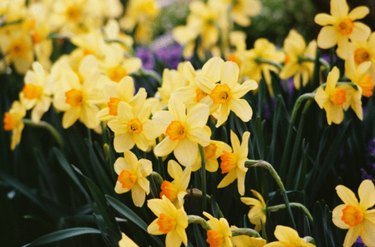Things You'll Need
Garden scissors
20-20-20 fertilizer

Deadheading is what you do when you prune off a plant's flowers after they fade. In some species, removing dead blooms induces the plant to produce new ones in the same season. In the case of daffodils, however, deadheading only prevents them from setting seed. The plant stores more energy in the bulb for next year's flower production if it doesn't have to make seeds. Deadheading a daffodil couldn't be a simpler process, with a couple of options for accomplishing the task.
Step 1
Cut the daffodil's flower stalks at the base of the plant as soon as the blooms die. Retain the foliage for six to eight weeks until it yellows and dries. During that period the daffodil's leaves use sunlight to produce food for storage in the bulb. Alternatively, follow the deadheading method described in step 2.
Video of the Day
Step 2
Find behind the flower head the point where the stalk makes the transition to the bloom. The area looks swollen when compared with the flower stalk's diameter. Cut the dead daffodil blossom just below the swollen section, taking it along. Retain the stalk and foliage for six weeks.
Step 3
Distribute 1 tbsp. of a 20-20-20 fertilizer around the base of each deadheaded daffodil plant. Water the fertilizer in to promote root development and increase bulb size for healthy bulbs next year. In six to eight weeks, prune the leaves and flower stalks back to the ground.
Video of the Day